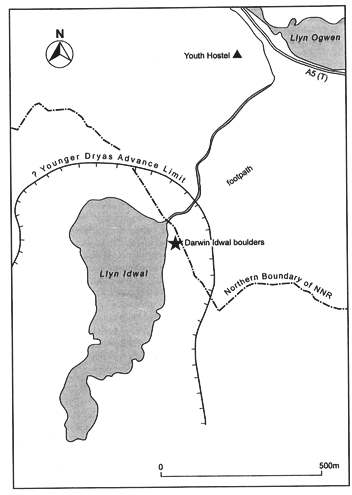
Events
On 9 June 1834, from the deck of HMS Beagle, Darwin was able to observe the calving glacier termini along the Magellan Channel below Mount Sarmiento in Tierra del Fuego. He also noted the associated transport of glacier-borne debris by icebergs into the marine environment. This experience was to influence his conceptual understanding of glacial geological processes heavily. It appears that he never actually walked to a glacier margin; but he cannot have escaped seeing the distinctive glacial landforms adjacent to those ice margins and the impact of glacier variations on the pattern of plant colonisation.
Incidentally, those of us fortunate enough to participate in the Society’s Bicentenary ‘In the footsteps of Charles Darwin’ field excursion to South America (picture) found that glacier calving was extremely limited due to substantial glacier recession during the 1834 – 2007 period, with virtually all the glacier termini now being essentially terrestrial. Certainly, significant iceberg generation had ceased and with it the transport of ice-rafted debris.
After his return to Britain, Darwin undertook a detailed field study of the Parallel Roads of Glen Roy in 1838 and concluded that they were shorelines of marine origin - an interpretation consistent with the concept of a recent great submergence. This was in accord with his observations of the effects of recent tectonic uplift process along the coast of Chile.
From June to November in 1840, Darwin was resident at Maer Hall in northwest Staffordshire (the home of his in-laws, the Wedgwoods) and an early manifestation of his illness prevented him from attending the Glasgow meeting of the BA. When, later, Agassiz, Buckland and Lyell each addressed the Geological Society at a series of three meetings between November 4 and December
2, Darwin travelled from Maer to London especially to be in attendance.
Technically he was still one of the two joint Secretaries of the Geological Society, although he had expressed a wish to resign. This became effective from February 1841. He was to witness firsthand the excitement and acrimony engendered by both Louis Agassiz and his principal supporting ‘convert’ William Buckland. In the next year, Buckland’s paper relating to his newly completed Snowdonia fieldwork was read (on December 15), but unfortunately illness again prevented Darwin from being present.
At the Geological Society, Darwin was not immediately persuaded by Agassiz’s and Buckland’s arguments for adopting a ‘glacialist’ interpretation of what had hitherto been mainly regarded as ‘diluvial’ phenomena. However, the subsequently published versions in the Society proceedings were sufficient to arouse his interest and he resolved to undertake a field test of the concept for himself in an area with which he was already familiar - North Wales. Indeed, he freely acknowledged that Buckland’s latest account acted as his ‘field guide’ when selecting localities worth visiting.
Thus, in June 1842 (just a month after completing his first written sketch of his ‘Origin of Species’ hypothesis at Maer and two months before he bought his new residence at Down House in Kent) he commenced a solo 10-day excursion to examine ‘glacial action’, with as his main objective the examination of evidence and interpretations presented by Buckland. He commenced his journey at Maer but first called at his birthplace and boyhood home, The Mount, in Shrewsbury.
His knowledge of north Welsh geology was in part due to the fact that in 1831, prior to his voyage in HMS Beagle, he had accompanied Adam Sedgwick to the principality. This earlier visit had been arranged so that Darwin might gain some supervised geological field training whilst Sedgwick was engaged in primary mapping.
Unlike the situation 11 years earlier, in 1842 ‘his eyes were now seeing what the mind was looking for’ and he was soon able to identify abundant landform and sedimentary evidence described by Buckland that was consistent with relatively recent glaciation. He almost instantly became a new member of the very select British group who supported the ‘Glacial Theory’ expounded by Agassiz. He stayed at the Royal Hotel (now the Plas y Brenin National Mountain Centre) in Capel Curig on 18 June and most probably from that base visited Cwm Idwal. The results of his new analysis of the north Welsh landscape were published in the same year
4. For much of the period 1840 – 1875, those supporting the glacialist creed, envisaged a combination of localised mountain glaciation followed by a major phase of marine submergence with extensive iceberg rafting of glacial debris, and Darwin was no exception.
As already noted, he did enjoy the rare advantage of having observed contemporary South American glaciers calving into the sea. In the British geological community at large, there was a clear majority (including the influential Sir Roderick Murchison) who were highly sceptical of the Glacial Theory in any aspect. A swing in favour of glacial processes in the pendulum of opinion was boosted by an Arctic glaciological expedition from the British Geological Survey in 1865 led by Archibald Geikie
5.